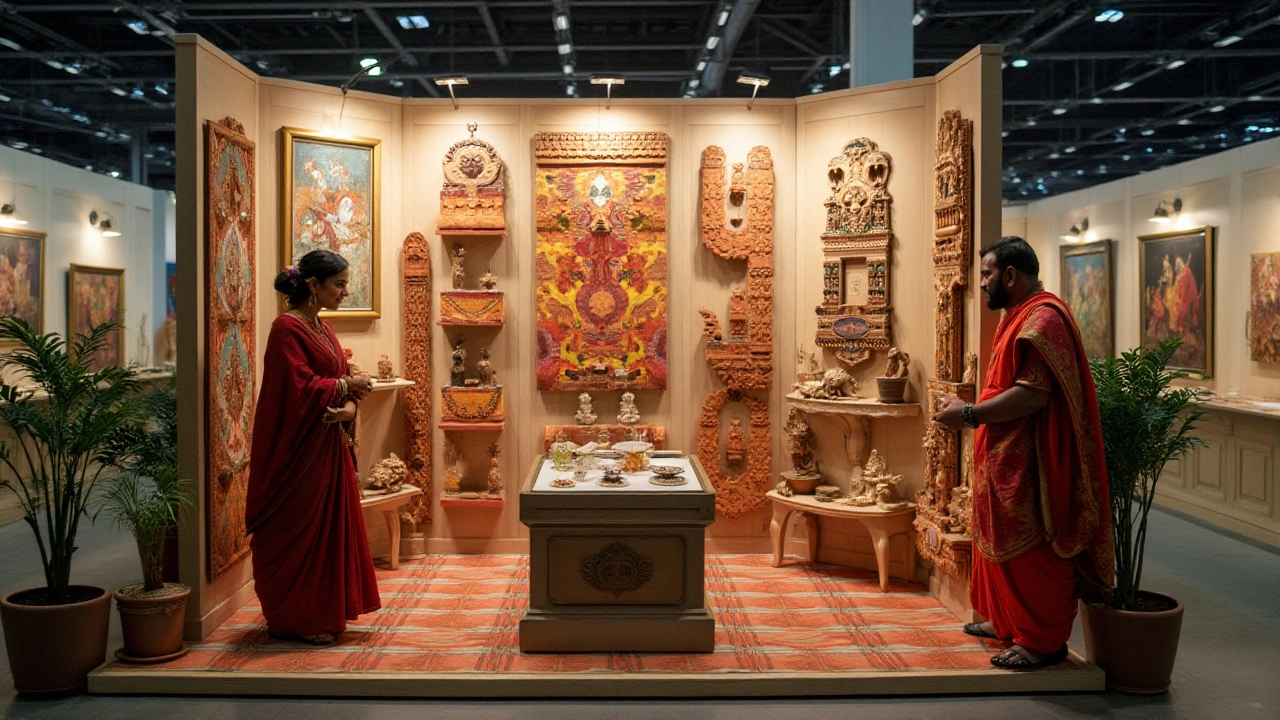Diving into the world of selling Indian handicrafts in the USA offers a rich opportunity to showcase cultural artistry to a diverse market. Yet, entering this market requires keen insights into both the potential of your products and the preferences of American consumers. The blend of traditional Indian crafts with modern tastes can create a compelling offering, but reaching customers demands strategic planning.
In this article, we'll explore the steps needed to effectively enter and thrive in this arena. From understanding market demands to navigating legalities, and from crafting a marketing plan to building relationships, each component is crucial. Entrepreneurs who appreciate both the art and business of handicrafts will find themselves well-prepared to make an impact in the US market.
- Understanding the American Handicraft Market
- Identifying the Right Handicraft Products to Export
- Navigating Export Regulations and Compliance
- Developing a Strong Marketing Strategy
- Building and Managing Distribution Channels
- Cultivating Relationships and Networking
Understanding the American Handicraft Market
Navigating the American handicraft market can feel like stepping into a vibrant mosaic of tastes, traditions, and untapped potential. The USA, known for its diverse cultural milieu, offers ample opportunity for Indian handicrafts to find eager buyers. Appreciating the nuances of this market begins with a deep dive into the preferences of its consumers. American buyers are particularly drawn to items that tell a story—pieces that reflect authenticity and cultural richness attract significant interest. Individualistic and unique crafts, often handcrafted in sustainable and eco-friendly ways, have captured the spotlight. This makes Indian products, with their heritage and detailed artistry, a natural fit for those who value craftsmanship and cultural depth.
Market trends show a growing inclination towards handmade and artisanal goods, spurred by the burgeoning demand for products that provide a personal touch in an increasingly mass-produced world. According to a 2023 report by the Art Business Institute, the global handicrafts market is predicted to grow annually at a surprising rate of 10.9%. This trend is reflected in the USA as consumers increasingly opt for meaningful over mundane. To align with this demand, exporters should focus on tightly-curated offerings that emphasize heritage and craftsmanship, staying vigilant about current design trends. A pivotal aspect of understanding this market is recognizing the importance of seasonal patterns. As festive occasions, such as Christmas and Thanksgiving, approach, there's a surge in demand for decorative items and giftware, a perfect niche for many Indian handicrafts.
One cannot overlook the boom of digital marketplaces in paving the way for artisans to reach a broader audience. E-commerce platforms such as Etsy and Amazon Handmade have brought about a sea change, enabling small artisans to sell directly to American consumers without the need for traditional retail intermediaries. This not only reduces overhead costs but also allows artisans to receive direct feedback from the market. Crucial to success in the US market is a robust online presence, coupled with engaging storytelling to elucidate the cultural significance behind each item. As quoted by René Redzepi, "Craftsmanship names an enduring, basic human impulse, the desire to do a job well for its own sake." It's this sentiment that American buyers increasingly respect and seek in their purchases.
For established and new entrants in the market, the diversity across the United States is both a challenge and an opportunity. Each region has distinct preferences, with urban areas often gravitating towards contemporary designs, whereas rural regions may appreciate traditional aesthetics. A successful strategy involves not only identifying but also segmenting your target demographic, allowing for targeted marketing efforts that cater to specific groups. An in-depth understanding of consumer behavior, purchasing power, and preferences across these varying locales will guide exporters to tailor their offerings accordingly, ensuring they cater to the right audience and tap into the conversations that matter most to them.
Identifying the Right Handicraft Products to Export
Choosing the best Indian handicrafts for the US market involves both creativity and strategic thinking. A deep understanding of American preferences, alongside knowledge of what India excels in crafting, can be a potent mix. Many US consumers are drawn to products that tell a story or have a cultural essence. Items like Madhubani paintings, Kashmiri carpets, and hand-woven textiles often capture hearts due to their intricate designs and rich backstories. However, market research is vital to uncover trends and demands. Platforms like Etsy and Amazon regularly showcase popular items among buyers, providing useful insights.
When venturing into exports, look for products that resonate with sustainability and ethical sourcing, as these are becoming important values among consumers in developed markets. Indian handicrafts made from recycled materials or using fair trade practices can hold substantial appeal. The tactile delight of hand-carved wooden items, the meditative charm of ceramics reflecting ancient traditions, or vivid home décor items produced from jute and cotton are increasingly capturing American interest. Sometimes fusing traditional designs with modern functionality can make a product even more desirable. For instance, creating a modern desk organizer using traditional Rajasthani pottery techniques can strike a perfect balance.
Seasonal trends and cultural events in the US also influence buying patterns. Products that tie into holidays like Christmas, Halloween, or the Fourth of July can see spikes in demand. Fashion trends may favor certain styles of jewelry or accessories, providing unique opportunities for Indian artisans skilled in silver filigree or semi-precious stone jewelry. Understanding these cycles can help in timing the entry of products to optimize visibility and sales.
A practical approach to verifying demand involves collaboration with local boutiques and participation in craft fairs. Such venues allow direct interaction with potential customers and offer first-hand feedback. This strategy enables exporters to fine-tune their product offerings and better cater to American tastes. It's important to remember that flexibility can be key; being willing to adapt designs based on feedback can lead to greater success.
“Consumers today appreciate connection to the makers,” says Emma Duke, an artisan market specialist, emphasizing the importance of storytelling in marketing.
Moreover, leveraging social media platforms can be a game-changer. Platforms like Instagram and Pinterest are excellent for showcasing the visually captivating nature of Indian handicrafts. Visual stories and influencers can amplify the reach and attractiveness of these products. Additionally, many consumers perform their shopping research online before making a purchase, so having a strong online presence is crucial. Ensure that each product listed has a compelling narrative, as well as high-quality images to entice potential buyers.
Indeed, exporting Indian handicrafts to the US is not just a transaction; it's a cultural exchange. It's about selecting products that have the potential to touch people's lives and adding a touch of Indian elegance to American homes. With careful selection and appropriate strategies, the beauty and craftsmanship of India can be successfully shared, creating not only revenue but relationships between two diverse regions.

Navigating Export Regulations and Compliance
Entering the US market with Indian handicrafts requires not just a passion for art but also a clear understanding of the complex web of export regulations. The US government places significant emphasis on compliance to ensure that all products meet safety, labeling, and environmental standards. For exporters, this means staying well-informed and prepared. Knowing the Harmonized Tariff Schedule (HTS) codes is essential, as it determines duties and taxes on imports. It’s vital to correctly classify your Indian handicrafts to avoid penalties and streamline shipping processes. Comprehensive knowledge of customs procedures can save precious time and resources, allowing for a smooth market entry.
Aside from tariffs, exporters must adhere to the Consumer Product Safety Improvement Act (CPSIA), which regulates the distribution of consumer goods like crafts. This act ensures the safety of products, particularly those intended for children. Companies need to maintain meticulous records proving compliance: testing results, product descriptions, and certifications. Be prepared for random inspections and create a compliance team to regularly audit practices and ensure ongoing adherence to regulations. Establishing a clear internal process to handle documentation is necessary for minimizing errors and avoiding issues that could disrupt business operations.
Understanding the export documentation requirements is equally crucial. Essential documents include the commercial invoice, packing list, and bill of lading. The Automated Export System (AES) is used to file electronic export information with the US Census Bureau, enhancing the efficiency and accuracy of trade statistics. Having a reliable freight forwarder can be indispensable; they offer expertise in logistics, reducing stress and allowing exporters to focus on growth strategies. Partnering with professionals in this field can demystify complex export procedures and open doors to new opportunities in the US market.
"Attention to detail and adherence to regulations is invaluable in international trade," advises regulatory expert Priya Kapoor. "Being proactive with compliance leads to smoother transactions and builds trust with American buyers."
In certain cases, additional permits or licenses might be necessary, especially when dealing with materials that fall under environmental or wildlife protections. Researching these aspects early in the process can prevent unexpected roadblocks. For example, items made from certain types of wood or containing specific dyes may have additional constraints tied to the Convention on International Trade in Endangered Species (CITES). Properly addressing these concerns not only ensures compliance but also strengthens the credibility of your brand among environmentally conscious consumers.
Lastly, staying updated on changes in trade agreements and policies can affect your US market strategies. The shifting landscapes of political relationships and trade negotiations can alter tariffs and trade laws, impacting the feasibility of your export plans. Joining industry associations or subscribing to trade publications ensures you remain informed and adaptive to new regulations. By navigating these channels effectively, exporters can safeguard their operations and strategically manage the dynamic world of international handicraft commerce.
Developing a Strong Marketing Strategy
Crafting a robust marketing strategy for Indian handicrafts in the US can seem like a daunting task. However, by focusing on realistic goals and understanding the distinct characteristics of the American market, you can carve out a niche that showcases your unique offerings. One pivotal aspect is storytelling. These products are not just items; they carry with them the essence of India's artistic heritage and cultural depth. By weaving these stories into your marketing campaigns, you can create an emotional connection with the audience, making them appreciate the emotional and cultural value of the products.
Next, it's crucial to identify who your target customers are. This involves not only assessing demographics but also psychographics, which includes understanding consumer values, interests, and lifestyles. The American market is incredibly diverse, so segmenting it into categories such as bohemian enthusiasts, home-decor aficionados, or eco-conscious buyers can lead to more targeted and effective promotions. Use social media platforms to your advantage by sharing visually appealing content that unravels the story behind each handicraft. Consider utilizing influencer marketing as well, where well-chosen influencers can lend credibility and broaden your outreach.
Pricing strategy plays a substantial role in your marketing efforts. Conducting a competitive analysis allows you to price your handicrafts in a way that reflects their intrinsic value while also being competitive. Consider offering tiered pricing for different segments, such as limited editions for collectors. Special promotions during cultural festivals or holidays can also drive sales, as they resonate with the cultural connections of these handicrafts. Such thoughtfully crafted promotions are not just about discounts but are about creatively showcasing the value proposition.
Brand development cannot be overlooked. Establishing a strong brand identity that reflects authenticity, quality, and sustainability is vital. Create a narrative around your brand that emphasizes these values across all marketing channels, be it newsletters, blogs, or your website. Consistency in messaging ensures that your brand remains memorable. Utilizing eco-friendly packaging that aligns with the values of environmental consciousness can further enhance your brand image.
Collaborating with local businesses in the US can provide a foothold into the market. This can be accomplished through partnerships with boutiques, galleries, or artisans that resonate with the Indian aesthetic. Hosting joint events or workshops can also increase visibility and open new pathways for engagement. Additionally, attending US trade shows dedicated to crafts or cultural products can be invaluable. These venues are excellent for networking and provide first-hand insight into trends and consumer preferences.
Lastly, don't underestimate the importance of gathering data. Analyze customer feedback, sales data, and market trends regularly. This information provides actionable insights to refine your marketing strategies and adapt to changing market demands. Employing analytics tools can aid in understanding which marketing efforts yield the most successful outcomes, allowing for an agile approach to growth.

Building and Managing Distribution Channels
Building effective distribution channels is crucial to successfully selling Indian handicrafts in the US market. It all starts with understanding the intricacies of your potential pathways—from direct sales to collaborations with online platforms and brick-and-mortar stores. Each channel offers its own set of advantages and potential pitfalls, but the goal remains the same: reaching customers efficiently and effectively. When considering the diverse geography and cultural landscape of the US, selecting the right partnership or channel can significantly impact your business performance.
To set the foundation, begin with direct-to-consumer sales. This method leverages the power of ecommerce, where your online presence through a dedicated website or platforms like Etsy and Amazon Handmade can spotlight your products to a vast audience. This approach offers the advantage of maintaining control over branding and customer interactions. Leveraging social media can be particularly potent here, as it provides a platform for storytelling around the heritage and craftsmanship embedded in each item. It also allows for quick feedback and direct communication with consumers, which can be vital in shaping and refining your offerings.
Engaging Retail and Wholesalers
Retail partnerships form the backbone of your distribution network. Consider collaborating with specialty stores that focus on cultural or artisanal products, as these establishments cater to customers seeking unique and handcrafted pieces. It’s beneficial to attend trade shows and craft expos, where personal connections with retailers and potential partners can be forged. Wholesalers, on the other hand, provide reach into various locations but often require a different pricing strategy to accommodate volume discounts. “Finding the right retail partners is akin to matchmaking,” says industry expert Maya Rogers.
“Their appreciation of the craftsmanship is as essential as their ability to sell.”
Distribution logistics neccessitates an understanding of customs regulations and shipping norms. Establishing partnerships with reliable shipping companies will ensure the timely and safe delivery of goods, keeping retailers and customers happy. Depending on the volume and nature of your products, third-party logistics providers could offer solutions that are both efficient and economically feasible. Having clear terms of sale helps set expectations and minimizes potential conflicts. Consider developing relationships with local artisans or small batches to meet the demand efficiently without straining production capabilities.
Leveraging Technology and Innovation
Technology can be a game-changer in managing distribution effectively. Implementing a smart inventory management system can help keep track of stock levels, sales, and shipments in real-time, reducing the risk of overselling or stockouts. It also enables you to analyze sales trends and adjust your production accordingly to meet demands without excess. Furthermore, exploring fulfilment by Amazon can expand your reach, as their vast network ensures quicker delivery times, satisfaction guarantees, and access to prime customers. Always keep an eye on innovation to introduce packaging that not only protects but adds value to the product, underscoring its cultural significance.
Cultivating Relationships and Networking
Building strong connections is at the heart of selling Indian handicrafts in the US market. Relationships foster trust and enable a smoother entry and expansion in the competitive landscape. One fundamental step in cultivating these connections is attending trade shows and exhibitions. These platforms not only spotlight your products to potential buyers but also offer a chance to meet other industry players and learn from their experiences. Establishing your presence at such events, even if it starts with a small booth, can pave the way for long-term business relationships.
Another vital aspect is leveraging digital networking platforms like LinkedIn and industry-specific forums. Engaging in meaningful discussions and sharing insightful content about the rich history and cultural significance of Indian handicrafts can help you to stand out. Being an active participant in such communities builds your reputation as a knowledgeable and committed supplier, enhancing your business visibility. Notably, connecting with established importers boosts credibility, offering a bridge to an extensive network of retailers and buyers.
"Networking is not about just connecting people. It's about connecting people with people, people with ideas, and people with opportunities." - Michele Jennae
Furthermore, consider forming alliances with US businesses that share a similar ethos in promoting ethical and sustainable products. Collaborations with local retailers who appreciate the craftsmanship of your exported goods can amplify your reach. Understanding their needs and offering tailored solutions reinforces your value in the marketplace. A personalized approach, such as sharing stories behind each handcrafted piece, emphasizes the uniqueness of your offerings and resonates with customers beyond mere transactions.
Participating in cultural events and collaborations with cultural bodies or educational institutions enhances your brand’s image, linking it with the broader narrative of cultural exchange. Sharing insights and offering workshops showcasing the traditional techniques of creating these crafts can also enrich your personal connections with stakeholders, fostering an emotional bond. As these relationships solidify, they provide invaluable word-of-mouth marketing, often the most trusted form of promotion in business.
Adapting to the local trends and preferences of the American market while maintaining the authenticity of Indian craftsmanship is imperative. Stay informed about trending styles, and use this information to engage with your network on how traditional techniques can be incorporated into modern designs. Regularly updating your network on new products or innovations keeps your business relevant and front-of-mind, potentially leading to new opportunities or partnerships.
Finally, invest time in understanding the cultural nuances of your American counterparts. Being culturally aware and respectful enhances personal relations, establishing you as more than just a vendor in their eyes. Remember, cultivating relationships is a two-way street; showing genuine interest and gratitude can turn business dealings into rewarding partnerships, fostering loyalty and long-term success in the sale of Indian handicrafts in the USA.


